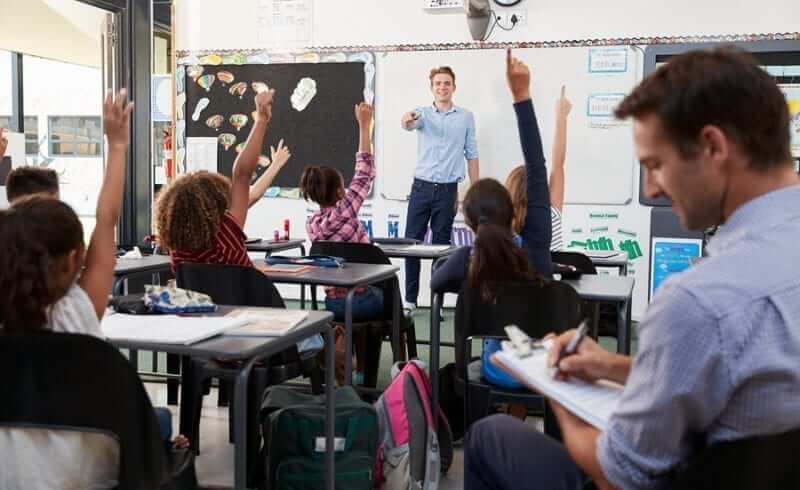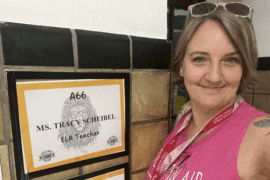Going for Gold on Your Next Classroom Observation
In our NJ teacher evaluation systems, scoring 4´s in everything is literally impossible. I laughed out loud when I attended the introductory meeting to Danielson and they told me that scoring 3’s were good and should be our goal, while 4’s were extraordinary, and in fact, not every lesson ALLOWS me to score a 4.
What???
Don’t they know who we are as teachers? You can’t dangle a gold star in front of me and then tell me to settle for less. Of course, we go for the gold! And do you know what? They are not as elusive as I had been led to believe. If you’re a good teacher, you´ll score well. But with some preparation, you´ll take home the gold star and the title, “highly effective¨ teacher from scoring all of those ¨distinguished” 4s.
Here’s a quick list of what should be included in a planned observation. For some more detailed pointers, read on below.
- Identify and deal with student misconceptions about the topic before and/or throughout lesson.
- Make a take home survey/question/activity to connect with family prior to lesson.
- Neat and orderly room- all supplies ready and organized.
- Student-run classroom management (established before observation.)
- Cross-curricular elements.
- Rubrics (with student input if possible before observation) handed out BEFORE lesson begins.
- Stated standards/curriculum/purpose of lesson posted or discussed.
- Connection to previous and future lessons discussed.
- Student-centered, highly engaging, with appeal to varying learning styles
- Technology infused.
- Student choices- the more the better.
- Strong content knowledge and awareness of standards.
- Self-assessment and student reflection questions at the end of class.
- Flexibility during lesson with post-lesson teacher reflection.
- High level questions and application throughout lesson.
Before the observation
Don’t make the mistake of thinking observations are just for the hour that the principal is in front of you. Observation prep begins on day one when you introduce yourself to the kids. Teach your kids the expectations you have for them starting in September, when it’s just you and them. Prepare them (and you) for someone watching by acting like someone is watching, all of the time. Teach them how to respect, how to behave, how to learn, think, question, and apply. Focus on management and routine till it’s seamless.
Teach them roles, class/group jobs, and transition skills until the kids are running the classroom under your now silent rules. Introduce them to the classroom in such a way that it becomes theirs, too. As a teacher, you know what your kids will need, so have it ready all the time, and allow kids to access it without your permission, following guidelines of respect, responsibility, and care.
Permanent stations are great: a research station, independent reading shelf, art supplies, measuring needs, etc.
Create other stations as needed for your units and lessons, and teach students the proper use before the day of the observation.
True mastery classroom management is achieved when the kids are managing themselves without you saying a word. While September is a lot of repetition, modeling, and correcting, the rest of the year you will be rewarded with easier days and smoother lessons (not to mention you will really impress any evaluator that walks through your door- scoring a 4 in classroom management).
Careful management is the cornerstone of a student run class, where we relinquish some of our control and let the kids lead the class under our very careful facilitation. This can take some practice — so don’t try this for the first time with a visitor planned in your room. Take the time to master this skill with your students, learning how to bend them toward ideas, emphasize teachable moments, and providing them guided experiences, while allowing their own individual ideas, personal experiences, and responses to mold the class.
September isn’t just about your students getting to know you, it’s about you getting to know them… and I mean REALLY get to know them. More than their names, identify their learning styles, their math and reading/writing abilities, their interests, their family backgrounds, their health concerns and educational needs (IRSC, 504, or IEP). Establish respectful, caring relationships with your students and their caregivers. And, it may be obvious, but know your subject. Read about it, research it, and talk about it. It shows in our lessons, and it shows during observations.
During the observation
Make sure you plan your observation well, but stick with your style of teaching, and not some showstopper that your students won´t know what to do with. That being said, they are looking for certain things in lessons. This may seem obvious, but READ your evaluation system. It’s a rubric, spelling out exactly how to score a distinguished 4.
Choose a lesson that is highly engaging to students, using hands-on learning and cooperative learning groups. As much as possible, get the kids involved in the decision making of the lesson, allowing for student choice, contribution for assessment, and flexibility in the lesson according to student response.
Plan for high-level thinking and concept application opportunities within the lesson. As far as curriculum goes, make sure you are not just considering the lesson at hand, but where you were before, as well as where you are going next. Today’s lesson is just a piece in the puzzle, and this should be expressed in your lesson.
Try to make it as cross-curricular as possible. As I tell my students, the real world does not just use one subject at a time. We need all of our skills to accomplish goals and solve problems outside of the classroom, so it only makes sense to apply this truth inside of the classroom. So, include math, language arts, science, social studies, and even art as much as possible into your lesson.
And, since I mentioned it, drawing real world applications from a lesson is always a plus. Include at least one element of technology- Chromebooks, tablets, slideshows, google classroom, etc. If possible, include some family interaction. This can be as simple as a letter home about the lesson, or the kids completing an at home survey, bring in a picture, drawing or object, or some element that they worked on at home with a parent or guardian. I usually introduce this before the observation day, so the kids have the ideas/drawing/objects with them for the observation. Make sure to use it, or draw attention to it during the observation.
Make sure the classroom is ready and neat. Make your copies, restock your supplies, straighten the rows, and clean out the art baskets. Consider the “what ifs”… and prepare for them as much as possible (including technology failures.) Don’t be afraid of the “what ifs.” Unplanned things happen every day in classrooms, and how you handle it says a lot about your teaching. So, when it happens, don’t panic; use it with the absolute knowledge that being flexible and responsive is a good thing in teaching (oh, and scores another 4).
Think about how the kids will relate/respond to the lesson. Consider what misconceptions and ideas students are bringing in with them and develop a way to identify and deal with that within the lesson. Tell the kids where you are going with the lesson- reviewing standards or essential questions. I have a board in the back of my room that has each lesson in a unit including the standards, essential questions, activities, and homework. Kids can see the lessons building, check in with their assignments, check their comprehension, and I can point it out whenever an evaluator steps into the room.
Offer kids a rubric, and if possible, let them contribute to its creation. They will care more if they feel like they were part of the assessment process, earn better grades because they know their expectations, and you will score your 4 due to your student-centered assessments.
Always include a self-assessment. We reflect as teachers, but they should also be reflecting on how they are doing as students within a group and classroom. When used correctly, self-assessments enable students to edit their work for better grades before handing it in. Take the time to listen to your kids, before, during, and after a lesson. Look for ways to improve any aspect of the lesson, and while you have a structured plan according to time and objectives, be as flexible as you can during the lesson, and modify as needed for the next time you teach the lesson.
After the observation
Reflect on your teaching and show it by updating the lesson plan, documents, and technology resources with changes after talking to the kids and observing their responses. Answer the evaluation reflection questions with real details and thoughts, and when you meet with your evaluator, talk about things that you learned and changed for the next class, as well as changes you made between classes (if you taught it more than once.) Bring student work, models, papers, rubrics, and self-assessments so that your evaluator can see the final outcome of the lesson.
Now that you know the trick of a good observation, you probably realize, it’s not really a trick at all, but a way of teaching. If these methods aren’t in your teaching, try them (before your observation so you can practice!) Having a well-managed, student-centered classroom where students (and teachers) are part of the learning process, responsible to know their expectations and empowered to reflect on their abilities and contributions, is a great approach in general! It is so much easier to prepare for observations if an evaluator can pop in on any day and find the elements of a good lesson.
Finally, don’t forget to breathe in, and breathe out. The hour that they spent with you, and the number that they assess you does not define your teaching. Don’t let the pressure affect your teaching. You teach for your kids, not a number, and that’s happening every day, whether you’re being observed or not. Most of our teaching happens behind our classroom doors with the only observers our students. The more important question should be, how would they score us?
-Jessica Cicalese-Kurtz
Jessica Cicalese-Kurtz, MA in k-12 Teaching and Technology, BA in k-8 Education, BS in Biology, Science and Engineering. Jessica is a middle school teacher at Toms River Schools, K-8 Science curriculum writer for Toms River Schools and Ocean County, an independent Science workshop creator and presenter, freelance writer.





